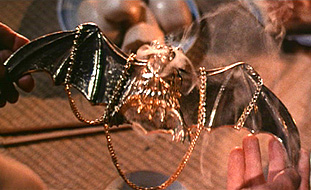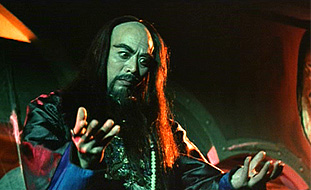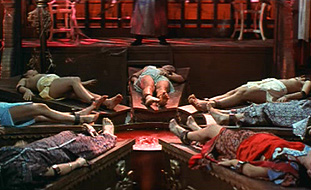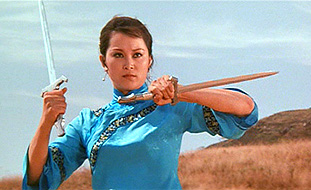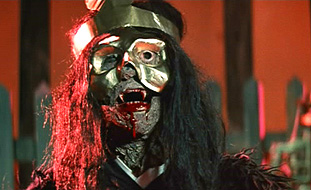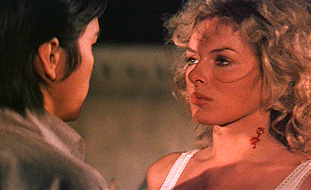|
||
|
Only one young man in the audience believes Van Helsing. For this young man, Hsi Ching, is from the very town that is beseiged by the seven golden-masked vampires. He has come to Chung King in hopes of enlisting Van Helsing's aid to free his village from the dominion of the Undead. SoVan Helsing undertakes an expedition through the Chinese wilderness, accompanied by a motley crew including Hsi Ching; his Kung Fu siblings; Van Helsing's plucky, mop-headed son Leyland; and the daringly "modern" heiress Vanessa Buren, who is traveling the world without the encumbrance of husbands or chaperones. Little does Van Helsing suspect that this journey will lead to a final confrontation with his arch-nemesis, Dracula, who in fact is the leader of the local vampire cult. Virtues and Vices Another limitation is the absence of Christopher Lee from the Dracula role. Even in scripts where he had few or no lines, Lee always made a larger-than-life impression. For this film, John Forbes-Robertson essays the role with more mundane results. On the plus side, the film offers the last chance to see Peter Cushing playing Professor Van Helsing. He makes a far different impression in this film than he did in Horror of Dracula. Sixteen years after cutting such a dashing and energetic figure in the first film, Cushing had become elderly, frail-looking and gaunt, almost skeletal. Fortunately, this look works well for a character who has spent his life fighting the Undead. And the Cushing's qualities of intelligence, intensity and absolute conviction are still there in full force. There is also something charmingly quaint about seeing Van Helsing in a pith helmet. Tangled Threads Also in the prelude, Dracula and Kah appear to merge into a single being with Kah's appearance, who returns to China. However, while Kah is still in China in 1905, Dracula has meanwhile been slain in Bavaria by Van Helsing in the 1890's. So for around a hundred years, Dracula was apparently alive in two forms: as the original Count in Transylvania, and under the guise of Kah in China. Small wonder that Van Helsing refers to him as "the arch-vampire"! Changing Times Vampire Lore When questioned on the best way to destroy the vampires, Van Helsing says: "A wooden stake, driven deep into the heart. Or better still, a silver shaft." However, he casts doubt on the efficacy of fire: "Not in Europe. In the East, perhaps. I don't know." Not all vampires are created equal. Dracula, it seems, is tops: "The arch-vampire. Lord of the Undead," as Van Helsing says; or, in the words of the Count himself: "I am Dracula, Lord of Darkness, Master of the Vampires, Prince of the Undead, Ruler of the Damned!" When Kah, the priestly servant of the seven golden vampires, needs help in reviving them, he travels all the way from China to Transylvania to ask Dracula's help. However, Dracula, as always in this series, remains completely free of any redeeming or sympathetic qualities: "Wretch!" he cries, "I do not grant favors. I do not accede to the requests of minions. Know you not, Dracula commands, even from the confines of this miserable place?" The seven golden vampires are also clearly special. Their golden masks and amulets, their temple, and the presence of a priest who provides them with sacrifices of young women, all suggest a good deal of power. Unlike the European vampire, however, they are horrifically ugly: wrinkled, decaying and definitely a bit senile-looking. The golden masks are perhaps not just for style, but also an expression of embarassment. The seven also remain silent throughout, so perhaps have lost the facility of speech. Yet they are clearly a cut above the next class of beings: hordes of zombie-like creatures that arise from their graves at the vampires' bidding. These creatures have faces that look like cheap Halloween skull masks. No one brings victims to them; they are used more like an army to assault the heroes' encampments. They show no signs of personality and little of intelligence, seeming to act as mere puppets under the control of the golden vampires. Of these unfortunate beings, Van Helsing says "They are [the seven vampires'] victims: the Undead. Their slaves throughout the ages." It was established earlier in the series that Dracula can be reincarnated by the black rites of his devotees. In this movie, it is stated that the seven golden vampires can also be reincarnated after they are slain. However, to reincarnate any one of them, it is apparently necessary to have access to the golden bat-shaped medallion that the vampire wore. Another singularity of the golden vampires is that they keep a large vat of blood at the center of their temple, and their victims lie on tilted slabs that drain into the vat. It is not clear for what unholy purpose this resevoir is kept. The vampire taint in China may be faster-acting than the European variety. One character becomes a vampire within moments of being bitten. (By contrast, recall the scene in Brides of Dracula where the creepy old lady waits by the graveside at dusk for the dead girl to rise again.) Dracula's Demise - Spoiler A nice touch, as Dracula's body distintegrates, is that his skull can be clearly seen to have fangs. Legend of the 7 Golden Vampire DVD: Click here for ordering information. |
||
|
Return to Contents Page for Baharna Books Background pattern from Owen Jones, The Grammar of Ornament Send comments to jfmorales@baharna.com |



